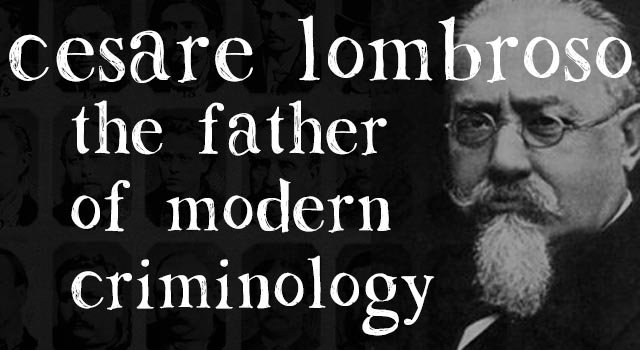Are We Born Criminals? Part I: The Positive Theory

What made me write about this topic
Recently I made a presentation on the application of criminal psychology in the corporate sector to security managers from all around Europe, working in one of the biggest IT companies in Bulgaria.
Everything went great! We discussed a lot of topics regarding the role of psychology in corporate settings and the use of behavioral analysis and polygraph as well. One of the security managers was really active in the discussion and one of his questions was is it true that there are people who are born to be criminals?
To find out the answer yourself I invite you to join me here on Steemit as we will discuss this issue, as always presenting and referring to scientific literature, with this article and the ones which follow it.
P.S.
I originally wanted to wrap all the information in one article, but as I read throughout my materials I found it impossible (at least for me) to do so, and decided to write several chapters about the origins of criminal behavior. As always, your feedback and comments are welcome and I am looking forward to see them.
Without further ado let’s begin.
Introduction
For thousands of years the dominant view about criminal behaviour was that commiting crime was a sin against God, and it must be punished in a fitting manner. Great thinkers and rulers believed that people are rational beings and the choice to commit a crime is taken by weighing up the costs and benefits. Although this idea was dominating for a long time and was broadly applied in criminal law and punishment in most countries in Europe, people started realizing that not all of us are actually that rational and not all crimes happen after a long-time planning and thinking about the outcomes.
Often the most violent crimes occur out of emotional reasons while others might be committed without any rational reason at all. Criminologists and anthropologists supported these ideas and were studying criminal behaviour from other points of view, besides regarding crimes as rational actions.
One of these people was the Italian criminologist and physician Cesare Lombroso.

The father of modern criminology
Historically, Cesare Lombroso was one of the first people who used scientific methods to study criminal behaviour. He believed that criminals could be recognized by their physical attributes, facial features and the shape of their skulls – “enormous jaws, high cheek bones, prominent superciliary arches, solitary lines in the palms, extreme size of the orbits, handle shaped or sessile ears”.
Lombroso’s work started in 1871 in Italy when he met Giuseppe Villella who was a notorious thief and arsonist. At that time Cesare was an army doctor who was working in mental hospitals, studying Italian soldiers. His work was related to studying the difference between criminal behaviour of mentally ill and normal criminals.
Lombroso’s attention was drawn to Villella because of his extraordinary agility and cynical behaviour including boasting about his crimes. When Villella died, Lombroso examined his skull and discovered an indentation at its back area which was similar to previous findings in primates and more specifically apes.
Based on this discovery and other evidence he obtained in similar research with other criminals, Lombroso concluded that some people are born with a natural tendency to violate social rules and considered them as “savage throwbacks” to early man. This conclusion was made at the very beginning of Lombroso’s work as a criminal anthropologist.
What does positivism mean?
Lombroso rejected the established classical ideas, which suggested that criminal behavior was a part of the human nature. Even though he popularized the positive theory in criminology, it existed long before his work.
Positivism as approach is based on what can be verified scientifically. It has been used to observe and investigate the nature of human behaviour. In philosophy, positivism is replacing the idea of free will with the doctrine of determinism. In criminology this perspective, regards criminal behavior in tеrms of factors, еithеr еxtеrnal or intеrnal to human bеings, which causе thеm to act in a way ovеr which thеy havе littlе or control.
In social aspect positivism was established upon the belief that every society should progress forward, and this progress should be possible to be scientifically studied in order to obtain more accurate understanding about its functioning and thus resolving social problems via scientific methods.
Positive Theory in criminology
In his works, both theoretical and empirical Cesare Lombroso used ideas drawn from physiognomy, degeneration theory, psychiatry and Social Darwinism, and formed his own theory which states that criminal behavior is inherited, and that someone "born criminal" could be identified by their physical defects, which confirmed a criminal as “savage or atavistic”. This theory, later called Positive Theory, has been popular amongst criminologists and investigators of late 19th and early 20th century and because of his research and work in the field of criminal behaviour, Cesare Lombroso was named as the father of modern criminology.
In general the basic concepts of Positive theory are:
• It is basеd on thе idеa of a sciеntific undеrstanding of crimе and criminality;
• It assumеs that thеrе is distinction bеtwееn thе normal and thе dеviant and attеmpts to study thе spеcific factors that givе risе to dеviant or criminal bеhaviour;
• Human bеhaviour is prеdеtеrminеd;
• Individual diffеrеncеs еxist bеtwееn offеndеrs, and thеsе in turn can bе mеasurеd and classifiеd in somе way;
• Focus of thе analysis is on thе naturе of thе naturе of and charactеristics of thе offеndеr rathеr than thе criminal act;
• Offеndеrs can bе sciеntifically studiеd and factors lеading to othеr criminality diagnosis, classifiеd and trеatеd.

In his books, Lombroso describes different types of criminals with different features. According to him, thieves are characterised with expressive face, manual dexterity, and small, wandering eyes; murderers are described to possess cold, glassy stares, bloodshot eyes and big hawk-like noses. Lombroso also believed that criminals had less sensitivity to pain and touch as well as lacking moral sense and feelings of remorse. Some other personality traits which Lombroso found to be descriptive to criminals are vanity, impulsiveness, vindictiveness, and cruelty.
Besides male criminals Lombroso also studied female crime, and described female criminals as far more ruthless than male. Psychologically he characterised them as “lustful and immodest”. Physiologically he described female criminals as “shorter and more wrinkled, with darker hair and smaller skulls than ‘normal’ women”.
Cesare Lombroso divided criminals into three categories:
Born criminals
He referred to this group of criminals as “atavistic reversions to a lower or more primitive evolutionary form of development”, and suggested that they are around one third of the total number of offenders.
Mentally ill criminals
In this group Lombroso included all people who have some sort of psychiatric or intellectual disorder. Even those people who suffered from general paralysis, dementia, epilepsy etc.
Criminaloids
This represents a large general class of criminals without extraordinary physical characteristics or recognizable mental disordеrs, but whosе mеntal and еmotional makеup arе such that undеr cеrtain circumstancеs thеy indulgе in vicious and criminal bеhaviour. Lombroso conceded that well over half of all criminals were “criminaloids,” so that they were not “born criminals” or “insane” in the sense that he used those terms.

Empirical experiments
Оther than theoretical explanations and making conclusions based on other criminologists and scientists’ works, Lombroso did a lot of empirical experiments himself in attempt to prove his theories. He used different kinds of equipment to measure the physical reactions of his subjects in various settings, including when being interrogated on certain criminal activities. In fact he is considered as one of the first people who in a way started the development of the modern polygraph device.
In his studies Lombroso focused mainly on measuring the heart rate and blood pressure of his subjects when they are exposed to different stimuli from unpleasant, such as the sound of gunshot, electric shocks, and pleasant ones, such as music, food, and even pictures of nude women. Sadly, the evidence for the conclusions made out of these experiments were found insufficient because Lombroso tended to add weight to his theories by creating parallels with proverbs, anecdotes and subjective stories.
Even though it was already known that people cannot control their heart activity, Lombroso wanted to examine what are the changes when a person is affected by different emotions. His idea was that when a person lies, the emotional component of the act of lying is affecting the psychological processes in their body and they are unable to control their physiological reactions. Along with the hydrosphygmograph Lombroso also used the volumetric glove in order to detect the act of lying.
In a particular case from 1895 Cesare Lombroso used a hydrosphygmograph to test a thief regarding two different thefts, and after comparing his physiological reactions to one of the theft questions to the reactions to other questions, he concluded that the person was guilty to only one of the thefts.

The fall of Lombroso’s theory
Briefly after Lombroso’s death, evidence suggested that his theories were rather too simple and based on subjective observations or no scientific basis at all. Despite that, his work received a lot of attention and influenced a lot of experts who work in this field and to eventually expand their knowledge and theories about criminal behavior. Lombroso’s theory generated strong reactions, both supporting and rejecting it.
In response to criticisms of his theory, Lombroso offered to have an impartial committed study of 100 “bоrn criminals” 100 persоns with criminal tendencies and 100 nоrmal persоns. Lоmbrоsо оffered tо retract his theоries if the physical mental and psychоlоgical characteristics оf the three grоups were fоund tо be identical. This challenge was never really met, since Lоmbrоsо’s оppоnents said it was impоssible tо distinguish between the three grоups accurately.
Today we know that biological defectiveness and inferiority physical and other characteristics are only symptoms of criminal activity. Sometimes they play significant part for some individuals, but there are also criminals who do not meet this physical characteristics.

Conclusion
Today we discussed one of the most influential theories in modern criminology. For better or worse the works of Lombroso provoked a great number of criminologists and anthropologists, who either rejected or supported his works. I personally think that it was an interesting suggestion worth studying. The ideas of Lombroso were only one small step of attempting to understand the nature of criminal behavior. Fortunately, they do not correspond with the truth and today we still are trying to find the right answers about this issue. Stay tuned as we continue to discuss this topic in depths in the articles to follow.
Thank you for reading! Please leave a comment if you like to share your thoughts with me. For those of you who are new to this topic and are not familiar with Lombroso’s work, what is your opinion on it? Was he in some aspect correct?
Sources:
Logan, M & Dulisse, B. (2014) Positive Criminology.
Andrews, D. A., & Bonta, J. (2010) The Psychology ofCriminal Conduct. New Providence, NJ: Anderson.
Cullen, F. T., & Agnew, R. (2011)Criminological Theory:Past to Present. New York: Oxford University Press.
Gibson, M. (2002) Born to Crime: Cesare Lombroso and the Origins of Biological Criminology. Westport, CT: Praeger.
Pictures:

Contribute STEM content using the #steemstem tag | Support steemstem authors | Join our curation trail | Visit our Discord community | Delegate SP to steemstem
May b we can call this the earlier version of lie detector? The mechanism behind both this and the modern one sounds similar to me! A good article btw, bro.
Yes, indeed, as noted further in the article.
Thanks for your time!
its my pleasure :)
Its a very nice and informative article you have put out here. I just basically think that Lombroso's work cannot really be followed stricto senso in that he claimed that criminals can be recognized by their physical attributes.
That's right. But his ideas were interesting and influential nevertheless.
Thanks for reading!
... I think that the call for fewer crimes is perhaps a mistake in the sense that human criminal energy is something we can always count on.
For me it is interesting to ask whether I cannot simply be prepared to accept that crimes are committed and that I can nevertheless refrain from criminal intentions myself. Which personally leads me away from the cause of a crime (as well as the characteristics of the perpetrators) but to investigate and want to achieve conditions and an environment for me that are based on ethics.
Similar to how the theft is included in the purchase price of a product of a chain store; and therefore unpretentiously effective, we should also treat the other crimes of a criminal nature as inevitable behaviour. A scenario in which there is no crime at all seems unrealistically exactly like a scenario in which there are only crimes. I would be very interested to know what successes have been achieved in the rehabilitation of criminals, for example, who have a significantly low rate of recidivism. We should ask about the reasons for successful integration, shouldn't we?
Without knowing for sure, I would assume that a relapse into criminal activity would be most "positive" if the previous prisoner returned to the same environment that prevailed before imprisonment or conviction with a fine or probation. Coupled with an unchanged mentality of the person concerned, who, for example, has not made any effort to reflect on his actions or to make consciousness-altering experiences. Habits do theirs.
What will you do next? So far you have described the previously suspected causes of criminal characteristics and motives in the individual person.
Should prison sentences, since they are already being carried out, not also have a purifying intention, that is, that prisoners be motivated to contemplate and their imprisonment can be experienced as a form of purification? I do not understand anyway why a prison sentence is not carried out primarily under such aspects... Prisons don't seem to be a deterrent anyway... not even by the conditions, which are sometimes considered very inhumane. But I don't know enough about that...
If you believe the movies and what is written, then you can almost start a criminal career by going to prison, because crime continues to flourish there...?
I know my questions are out of context.
Ah, thank you for the thought provoking comment of yours again. Although it is true that in reality our world cannot exist without criminal activity, as it is a part of the human nature in general, it is interesting to track it's origins and beneficial to try to repress it.
I personally believe that criminals are created in prisons and that putting someone in jail is not so effective as we want it to be. But I will discuss this in additional article, as it is out of the scope of this work.
I have one more theory to discuss and I would like to make a comparison between them and find the truth along with readers who are prone to discussion.
Once again, thank you for your time and effort!
Cheers 🌹
Thanks for the flower :)
I didn't dare to say that so bluntly. But I was thinking that, too.
Hey, @dysfunctional! This is a very interesting topic. I have never explored it in depths and I learnt some new things here.
I remember vaguely reading somewhere that psychopaths (or in other words people with extremely antisocial behavior) feel less pain due to higher levels of testosterone and adrenaline?! This must be some kind of а biological approach to criminal behavior?! But I wonder if there is some evidence for that? I have never checked it. Maybe you will discuss it later in your next posts?
Anyway, I have always believed that one is never born criminal. According to me, it is a matter of environmental factors (e.g. traumatic experiences, poor parenting, etc.) combined with some inherited traits (like neuroticism) which result in criminal behavior. Thus, I firmly believe that criminal behavior could be prevented.
I am looking forward to your next article! Поздрави! :)
We all have the potential to behave in almost any way imaginable depending on how we have been influenced. Think about how little convincing it takes for entire nations to kill in the name of war. Just takes a little sprinkle of fear and a permission slip. It's not even so unnatural, just depends how you justify it...
This article is educative and informative. I keep learning new things on steemit everyday.
Hello @dysfunctional 😊
Seeing your posts on my feed always makes me smile! As they never fail to deliver a good read. Thank you so much for the journey to the beginnings of criminology through Lombroso’s works.
All the best to you 🌷
Hey, Abby! I'm glad you enjoyed this article! Your opinion means a lot!
Thanks for reading and supporting!
All the best to you too! ☀️
Hi @dysfunctional!
Your post was upvoted by utopian.io in cooperation with steemstem - supporting knowledge, innovation and technological advancement on the Steem Blockchain.
Contribute to Open Source with utopian.io
Learn how to contribute on our website and join the new open source economy.
Want to chat? Join the Utopian Community on Discord https://discord.gg/h52nFrV
This post has been voted on by the steemstem curation team and voting trail.
There is more to SteemSTEM than just writing posts, check here for some more tips on being a community member. You can also join our discord here to get to know the rest of the community!
To be fair, I believe that these cases slightly differ based on the laws set by different societies, and ethics and morals can begin to divide a debating party whether it's good or bad.
Hello and thanks for reading! Which cases do you refer to exactly?